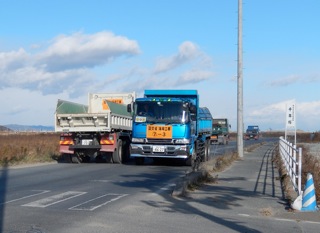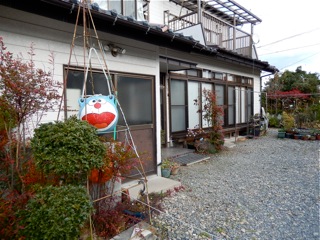A Visit to Fukushima
- At July 27, 2016
- By anneblog
- In Annes Letters
 0
0
December 2013
Dear Family and Friends,
One of the positive things happening now in Sendai is all the reconstruction going on. The government has provided generous loans to rebuild, so old houses are being replaced by new ones. Also the entire sewer system is being renewed; and electric lines are being reinforced and more securely positioned. In other words, for most people, there is a very strong sense of hope and of moving forward.

But step out of Sendai and things start to change. In Miyagi and Iwate Prefectures much of the tsunami debris has been cleared, but recovery is slow. In fishing areas, for example, people are saying another thirty or more years will be needed to get things back to where they were, if ever. However, once the Trans-Pacific Partnership (TPP) comes into effect, this rural area of farmers and fishermen may never get back on its feet. But even so, in Miyagi and Iwate Prefectures building is going on continually. Roads are full of trucks plying back and forth.

People are clearing the land of salt so planting can start again.

Small businesses are beginning to pop up along the main roads. And where people can, new homes are appearing. So a sense of progress, albeit slow, is being felt everywhere.
But Fukushima is another world entirely.
Minami Soma is a town just within the infamous twenty-kilometer radius of the Fukushima Nuclear Power Plant. Immediately after the meltdown, all townspeople were ordered to evacuate, taking only what they could carry with them. The place became off limits for anyone besides people working at the power plant. And they, of course, could only enter wearing enormous protective gear and were restricted as to how long they could stay in that diabolical zone.
The situation continued much the same for townspeople for over a year. Families were either put into temporary housing units or moved to other regions of Japan. Often several generations who had lived together as extended family were broken up and sent to differing places to live. In the meantime, the problems at the plant went from bad to worse, maybe a bit better, but then worse again. Even now, the dilemma remains formidable with no clear solution in sight.
Despite the ongoing nightmare, for some reason the radiation levels on the outer limits of the twenty-kilometer “No Entry” zone seem to have gone down. So about a year ago visiting restrictions were lifted for people who had homes there.
However, there was a further sad dimension of Minami Soma’s already tragic story. Once news got out about the town’s evacuation, organized crime came creeping in. Thieves arrived to loot whatever they could sell, knowing that things of great value had been left behind. The man who told me this said, “The greatest loss were the family altars. For us Japanese they hold the spirit of our ancestors, stretching back for centuries. We can lose furniture or heirloom kimonos, farm equipment or money, but to lose our Butsudan is to lose our souls.”

Finally the situation became so bad that armed guards were stationed around the whole area. Even now it has a reputation of being unsafe, not so much because of nuclear fallout, but because of disreputable, greedy human beings and what they might do. Because of that danger, people are allowed to be there only during daylight hours.
Besides residence, volunteers have recently come to the town to help clear up the mess that the tsunami left. Very touchingly several of them were young doctors doing internships in a nearby hospital.

They told me the illness they saw everyday were “the normal kind”, like colds and flu. They added that the people of the area were regularly checked for radiation, which always fell within acceptable levels. “Be sure to tell people this area is now safe. Some places with no nuclear problems have higher levels than are found here. It’s important for people to know that. Fukushima has such a sad reputation now, but it doesn’t have to be that way.”
This volunteer clean-up work is starting up almost three years since the disaster. So going to that area is like stepping back in time. Buildings on the edge of town are still smashed up, abandoned cars dot the fields, curtains flap from broken windows, and even faded carp streamers of long ago still flutter in the breeze.



The town of Minami Soma itself was not hit by the tsunami, so houses are still in tact. At a cursory glance, it seems like a normal place, with maybe everyone inside for lunch. But as you stroll down the street, an eerie feeling begins to seep in. Then it dawns on you how much of a ghost town it has become. In fact, the atmosphere haunts with its deadly emptiness.

To add to the bizarre feeling, some things appear as if life were continuing normally. There is a line up of bicycles at the now-empty train station, for example. There are flowers and children’s toys outside homes, dish soap and hand cream left on widow sills. And then-new signs are boldly displayed in front of shops.



Of course, all of these images and feelings evoke profound questions. What future do the towns near the nuclear power station have? With all the economic problems the Japanese government and the Tokyo Electric Power Company have, will they be able to finance the tremendous cost of rebuilding those nuclear-devastated towns? Or will they turn their backs on the people, the land, and the problems, as they too struggle to move forward in these greatly precarious times?
Love,
Anne



